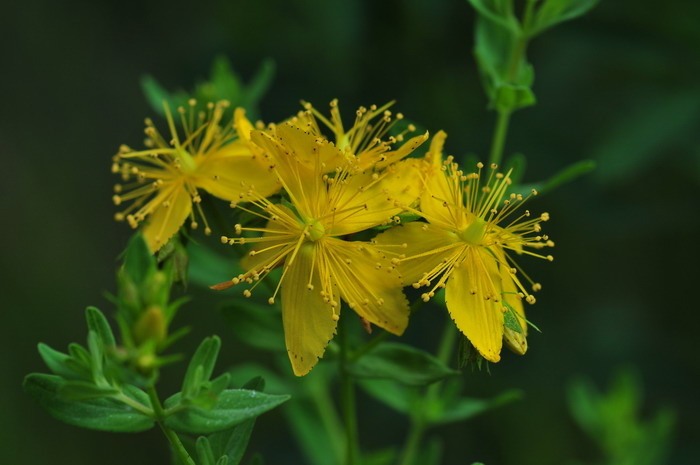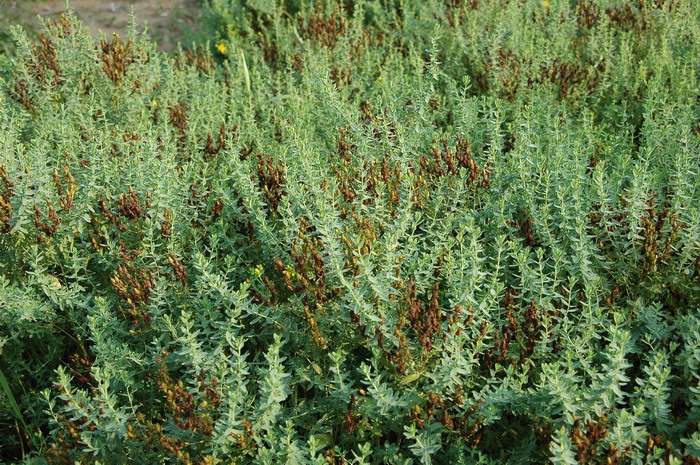贯叶连翘Hypericum perforatum
中文名(Chinese Name):贯叶连翘
学名(Scientific Name):Hypericum perforatum L.
英文名(English Common Name):common St. Johnswort
别名(Chinese Common Name):小金丝桃、铁帚把
异名(Synonym):Hypericum perforatum var. confertiflora Debeaux Hypericum deidesheimense Sch.Bip. ex Trevir. Hypericum lineolatum Jord. Hypericum marylandicum Biroli ex Colla Hypericum mixtum Des Moul. Hypericum officinale Gaterau Hypericum officinarum Crantz Hypericum perforatum var. albiflorum Choisy Hypericum perforatum var. alpinum Parl. Hypericum perforatum var. anomalum Frid. Hypericum pseudoperforatum Bertol.
科属(Family & Genus):藤黄科(Guttiferae)金丝桃属
形态特征(Description):多年生草本,高20-60厘米,全体无毛。茎直立,多分枝,茎及分枝两侧各有1纵线棱。叶无柄,彼此靠近密集,椭圆形至线形,长1-2厘米,宽0.3-0.7厘米,先端钝形,基部近心形而抱茎,边缘全缘,背卷,坚纸质,上面绿色,下面白绿色,全面散布淡色但有时黑色腺点,侧脉每边约2条,自中脉基部1/3以下生出,斜升,至叶缘连结,与中脉两面明显,脉网稀疏,不明显。花序为5-7花两岐状的聚伞花序,生于茎及分枝顶端,多个再组成顶生圆锥花序;苞片及小苞片线形,长达4 毫米。萼片长圆形或披针形,长3-4毫米,宽1-1.2毫米,先端渐尖至锐尖,边缘有黑色腺点,全面有2行腺条和腺斑,果时直立,略增大,长达4.5毫米。花瓣黄色,长圆形或长圆状椭圆形,两侧不相等,长约1.2毫米,宽0.5毫米,边缘及上部常有黑色腺点。雄蕊多数,3束,每束有雄蕊约15枚,花丝长短不一,长达8毫米,花药黄色,具黑腺点。子房卵珠形,长3毫米,花柱3,自基部极少开,长4.5毫米。蒴果长圆状卵珠形,长约5毫米,宽3毫米,具背生腺条及侧生黄褐色囊状腺体。种子黑褐色,圆柱形,长约1毫米,具纵向条棱,两侧无龙骨状突起,表面有细蜂窝纹。花期7-8月,果期9-10月。
分布(Distribution):产华北、西北、华中、西南等部分省区。生于海拔500-2100米山坡、路旁、草地、林下及河边等处。南欧、非洲、远东、中亚、印度至蒙古和俄罗斯也有。
用途(Use):
引自中国植物志英文版FOC Vol. 13 Page 5, 30, 31
Hypericum perforatum Linnaeus, Sp. Pl. 2: 785. 1753.
贯叶连翘 guan ye lian qiao | Clusiaceae | Hypericum
Hypericum perforatum var. confertiflorum Debeaux; H. perforatum var. microphyllum H. Léveillé (1908), not Candolle (1815).
Herbs, perennial, 20-60(-100) cm tall, erect from creeping and rooting base; stems numerous to few, much branched especially distally. Stems 2-lined, with few black glands on lines. Leaves sessile to subsessile; blade ± narrowly elliptic to ± narrowly oblong or linear, (0.7-)1-2.5(-3) cm × 3-7(-15) mm; thickly papery, abaxially paler; laminar glands pale, scattered and sometimes black, few, dots; intramarginal glands black, spaced, interspersed with small dense pale ones; main lateral veins ca. 2-paired, tertiary reticulation lax or scarcely visible; base subcordate-amplexicaul to rather narrowly cuneate, margin entire, plane or ± recurved, apex obtuse. Inflorescence 3- to numerous-flowered, from 1-3 nodes; flowering branches curved-ascending from up to 15 or sometimes more nodes below, the whole nearly flat-topped to broadly pyramidal or cylindric; bracts and bracteoles to 4(-7) mm, narrowly lanceolate to linear, margin entire. Flowers 1.5-2.5(-3) cm in diam., stellate; buds narrowly ovoid, apex acute. Sepals free, erect in bud, recurved in fruit, narrowly oblong or lanceolate to linear, equal, 3-4(-5) × 1-1.2 mm; laminar glands pale and often a few black, in 2(-4) rows, streaks (basally) to dots; intramarginal glands black, few, or absent; margin entire, apex acute to acuminate with tip somewhat glandular; veins 3(-5). Petals golden yellow, oblong to oblong-elliptic, (0.8-)1.2-1.5 cm × 5-6 mm, 3-4 × as long as sepals, asymmetric; laminar glands black or pale, dots to lines, or often absent; intramarginal glands black or pale, distal, in sinuses when present; margin distally ± crenate. Stamens 40-60, apparently 3-fascicled, longest 6-8 mm, 0.5-0.7 × as long as petals. Ovary narrowly ovoid to ovoid-ellipsoid; styles 3, 4.5-6 mm, 1.5-2 × as long as ovary, broadly to rather narrowly spreading. Capsule ovoid-conic to ovoid, 3-6.5 × 3-5 mm, 1-1.5 × as long as sepals; valves with abaxial vittae and lateral yellowish, elongate or short vesicles. Seeds dark brown, ca. 1 mm; testa finely linear-foveolate. Fl. Jun-Sep, fr. Jul-Oct. 2n = 32, 48.
Open woodlands, meadows, grasslands, and steppes, riverbanks, stony and grassy slopes, roadsides, in dry or well-drained habitats; 100-2800 m. Gansu, Guizhou, Hebei, Henan, Hubei, Hunan, Jiangsu, Jiangxi, Shaanxi, Shandong, Shanxi, Sichuan, Xinjiang, Yunnan [NW India, Kazakhstan, Kyrgyzstan, Mongolia, Russia; NW Africa, SW to C Asia, Atlantic islands, Europe (except extreme N); introduced into many parts of the world].
Hypericum perforatum is apparently an allotetraploid that would appear to have arisen from a cross between two diploid taxa, namely H. maculatum subsp. immaculatum (Balkan Peninsula) and H. attenuatum (W Siberia to China).
In both the SW (S Europe, Mediterranean) and SE (China) parts of its range, small-leaved forms of Hypericum perforatum evolved, and both have been named var. microphyllum (respectively by Candolle in 1815 and H. Léveillé in 1908). This more southern Chinese form (var. confertiflorum Debeaux), which intergrades morphologically with the larger-leaved more northern Chinese form, has small, narrow leaves, with dense, smallish partial inflorescences remaining distinct on elongate, widely ascending branches.
Hypericum perforatum has been subdivided into four subspecies, of which two occur in China.

 (责任编辑:徐晔春)
(责任编辑:徐晔春)
学名(Scientific Name):Hypericum perforatum L.
英文名(English Common Name):common St. Johnswort
别名(Chinese Common Name):小金丝桃、铁帚把
异名(Synonym):Hypericum perforatum var. confertiflora Debeaux Hypericum deidesheimense Sch.Bip. ex Trevir. Hypericum lineolatum Jord. Hypericum marylandicum Biroli ex Colla Hypericum mixtum Des Moul. Hypericum officinale Gaterau Hypericum officinarum Crantz Hypericum perforatum var. albiflorum Choisy Hypericum perforatum var. alpinum Parl. Hypericum perforatum var. anomalum Frid. Hypericum pseudoperforatum Bertol.
科属(Family & Genus):藤黄科(Guttiferae)金丝桃属
形态特征(Description):多年生草本,高20-60厘米,全体无毛。茎直立,多分枝,茎及分枝两侧各有1纵线棱。叶无柄,彼此靠近密集,椭圆形至线形,长1-2厘米,宽0.3-0.7厘米,先端钝形,基部近心形而抱茎,边缘全缘,背卷,坚纸质,上面绿色,下面白绿色,全面散布淡色但有时黑色腺点,侧脉每边约2条,自中脉基部1/3以下生出,斜升,至叶缘连结,与中脉两面明显,脉网稀疏,不明显。花序为5-7花两岐状的聚伞花序,生于茎及分枝顶端,多个再组成顶生圆锥花序;苞片及小苞片线形,长达4 毫米。萼片长圆形或披针形,长3-4毫米,宽1-1.2毫米,先端渐尖至锐尖,边缘有黑色腺点,全面有2行腺条和腺斑,果时直立,略增大,长达4.5毫米。花瓣黄色,长圆形或长圆状椭圆形,两侧不相等,长约1.2毫米,宽0.5毫米,边缘及上部常有黑色腺点。雄蕊多数,3束,每束有雄蕊约15枚,花丝长短不一,长达8毫米,花药黄色,具黑腺点。子房卵珠形,长3毫米,花柱3,自基部极少开,长4.5毫米。蒴果长圆状卵珠形,长约5毫米,宽3毫米,具背生腺条及侧生黄褐色囊状腺体。种子黑褐色,圆柱形,长约1毫米,具纵向条棱,两侧无龙骨状突起,表面有细蜂窝纹。花期7-8月,果期9-10月。
分布(Distribution):产华北、西北、华中、西南等部分省区。生于海拔500-2100米山坡、路旁、草地、林下及河边等处。南欧、非洲、远东、中亚、印度至蒙古和俄罗斯也有。
用途(Use):
引自中国植物志英文版FOC Vol. 13 Page 5, 30, 31
Hypericum perforatum Linnaeus, Sp. Pl. 2: 785. 1753.
贯叶连翘 guan ye lian qiao | Clusiaceae | Hypericum
Hypericum perforatum var. confertiflorum Debeaux; H. perforatum var. microphyllum H. Léveillé (1908), not Candolle (1815).
Herbs, perennial, 20-60(-100) cm tall, erect from creeping and rooting base; stems numerous to few, much branched especially distally. Stems 2-lined, with few black glands on lines. Leaves sessile to subsessile; blade ± narrowly elliptic to ± narrowly oblong or linear, (0.7-)1-2.5(-3) cm × 3-7(-15) mm; thickly papery, abaxially paler; laminar glands pale, scattered and sometimes black, few, dots; intramarginal glands black, spaced, interspersed with small dense pale ones; main lateral veins ca. 2-paired, tertiary reticulation lax or scarcely visible; base subcordate-amplexicaul to rather narrowly cuneate, margin entire, plane or ± recurved, apex obtuse. Inflorescence 3- to numerous-flowered, from 1-3 nodes; flowering branches curved-ascending from up to 15 or sometimes more nodes below, the whole nearly flat-topped to broadly pyramidal or cylindric; bracts and bracteoles to 4(-7) mm, narrowly lanceolate to linear, margin entire. Flowers 1.5-2.5(-3) cm in diam., stellate; buds narrowly ovoid, apex acute. Sepals free, erect in bud, recurved in fruit, narrowly oblong or lanceolate to linear, equal, 3-4(-5) × 1-1.2 mm; laminar glands pale and often a few black, in 2(-4) rows, streaks (basally) to dots; intramarginal glands black, few, or absent; margin entire, apex acute to acuminate with tip somewhat glandular; veins 3(-5). Petals golden yellow, oblong to oblong-elliptic, (0.8-)1.2-1.5 cm × 5-6 mm, 3-4 × as long as sepals, asymmetric; laminar glands black or pale, dots to lines, or often absent; intramarginal glands black or pale, distal, in sinuses when present; margin distally ± crenate. Stamens 40-60, apparently 3-fascicled, longest 6-8 mm, 0.5-0.7 × as long as petals. Ovary narrowly ovoid to ovoid-ellipsoid; styles 3, 4.5-6 mm, 1.5-2 × as long as ovary, broadly to rather narrowly spreading. Capsule ovoid-conic to ovoid, 3-6.5 × 3-5 mm, 1-1.5 × as long as sepals; valves with abaxial vittae and lateral yellowish, elongate or short vesicles. Seeds dark brown, ca. 1 mm; testa finely linear-foveolate. Fl. Jun-Sep, fr. Jul-Oct. 2n = 32, 48.
Open woodlands, meadows, grasslands, and steppes, riverbanks, stony and grassy slopes, roadsides, in dry or well-drained habitats; 100-2800 m. Gansu, Guizhou, Hebei, Henan, Hubei, Hunan, Jiangsu, Jiangxi, Shaanxi, Shandong, Shanxi, Sichuan, Xinjiang, Yunnan [NW India, Kazakhstan, Kyrgyzstan, Mongolia, Russia; NW Africa, SW to C Asia, Atlantic islands, Europe (except extreme N); introduced into many parts of the world].
Hypericum perforatum is apparently an allotetraploid that would appear to have arisen from a cross between two diploid taxa, namely H. maculatum subsp. immaculatum (Balkan Peninsula) and H. attenuatum (W Siberia to China).
In both the SW (S Europe, Mediterranean) and SE (China) parts of its range, small-leaved forms of Hypericum perforatum evolved, and both have been named var. microphyllum (respectively by Candolle in 1815 and H. Léveillé in 1908). This more southern Chinese form (var. confertiflorum Debeaux), which intergrades morphologically with the larger-leaved more northern Chinese form, has small, narrow leaves, with dense, smallish partial inflorescences remaining distinct on elongate, widely ascending branches.
Hypericum perforatum has been subdivided into four subspecies, of which two occur in China.
踩一下[0]

顶一下[2]